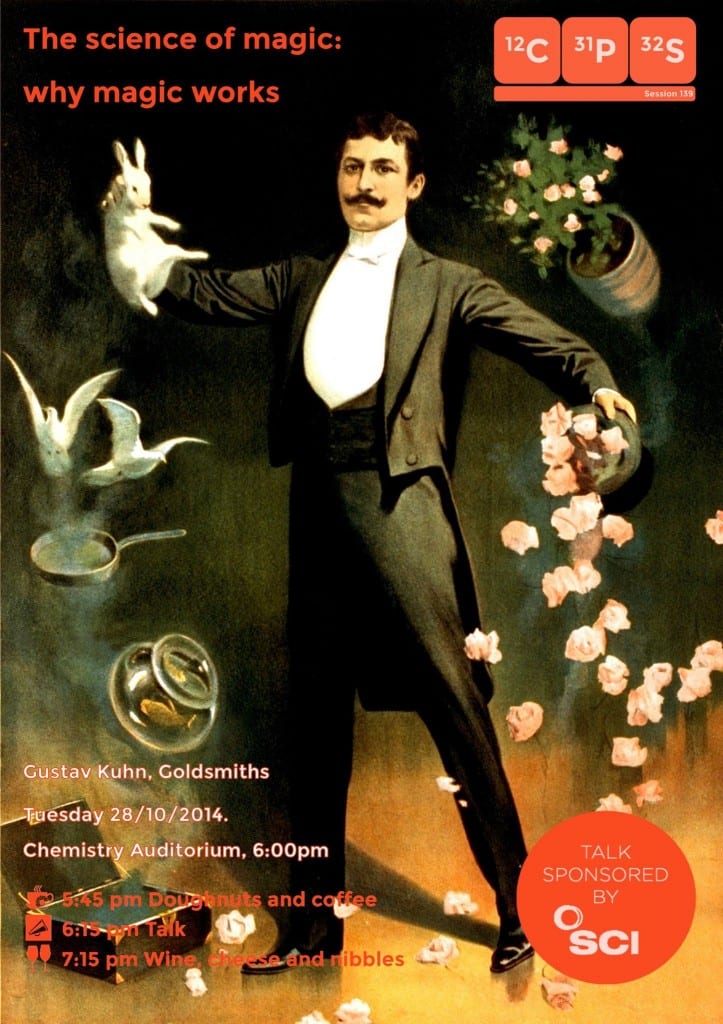The Science of Magic: Why Magic Works – CPS Talk 28/10/14
By Penny Carmichael, on 4 November 2014
– Article by Stephen Leach
VISUAL COGNITION TAKES 0.1 SECONDS, SO READING THIS WON’T TAKE YOU LONG.
The Chemistry Auditorium is no stranger to magic, I’ve had a few lectures in there that have been really memorable. However, last Tuesday evening a bona fide entertainer graced the stage: Dr Gustav Kuhn; Magician and Psychologist from Goldsmiths University London. Magic and science – who would unite such contrary disciplines? Dr Kuhn uses the cognitive loopholes exploited by magicians in order to probe the inner workings of our brains. Here follows a brief and incomplete iteration of how Dr Kuhn demonstrated to us how magic informs science.
Firstly he set out a definition: “magic is the conflict between what we see and what we believe is possible”. It is therefore a concept of our own construction, limited consciously by our belief system and unconsciously by our neural network. Magicians employ illusion and misdirection in order to achieve their sordid goals and their success is due to the perceptual frailties that already exist in our minds. Frailties is an unfair term, I suppose we consider it a failure when we are tricked but consider the case of the ‘Hollow Mask’ illusion. If you have never seen it, enter it into your favourite search engine and prepare to be impressed for the duration of a masks rotation. It’s a case of the habitual reinvention by our brains of what we observe, which in this case is no frailty. There are some primeval processes at work that get working in our brains long before logic or reasoning has a chance to chime in.
One way to expose neural activity is functional MRI and it has been carried out on people subjected to magic tricks. They found that an area of the brain called the Posterior Cingulate Cortex fizzes the most. The analogy Dr Kuhn made was that it is like when you automatically walk home along a well-rehearsed route and you have to consciously remember to buy milk. The PCC is the part of the brain that gets annoyed when you forget to buy milk and have to settle for black tea.
If you are tricked don’t dismay, it just means that you are following the social cues crafted by the magician. From eye tracking experiments Dr Kuhn showed us that the ‘tricked’ person can be misdirected constantly, having their attention diverted to the places that will insure they are eventually dumbfounded. The social cue can be a simple gesture that will misdirect the audience at the precise moment of trickery.
Dr Kuhn is particularly interested in visual perception and highlights how our focus is rather narrow when subjected to numerous stimuli. The brain is forced to conduct a thorough editorial regarding what’s important and tends to fill in a lot of blanks as it sees fit. Being able to see movement in our peripheral vision could have helped our ancestors to avoid predation but to see colours in our peripheries is not so important. We only observe colour in what we are directly looking at, the brain fills in the rest. The brain is pretty neat, but has its foibles. Dr Kuhn asked the audience to participate in a ‘Change Blindness’ task. This is when our perception becomes… blind to some change. It featured a ‘spot the difference’ between two alternating photographs, why don’t you cruise the internet for a gif. for 5 seconds of entertainment and see if you too are blind to change.
In conclusion I was so engrossed in what Dr Kuhn was saying and doing that I forgot to write anything much down, in my defence I was just following the social cues. For his final trick I was hoping Dr Kuhn would make some members of the audience disappear, specifically the four guys sat behind me who couldn’t keep their mouths closed. Just in it for the pizza no doubt. tut tut.
Next up, origins of life.
 Close
Close



 Subscribe to this blog!
Subscribe to this blog!